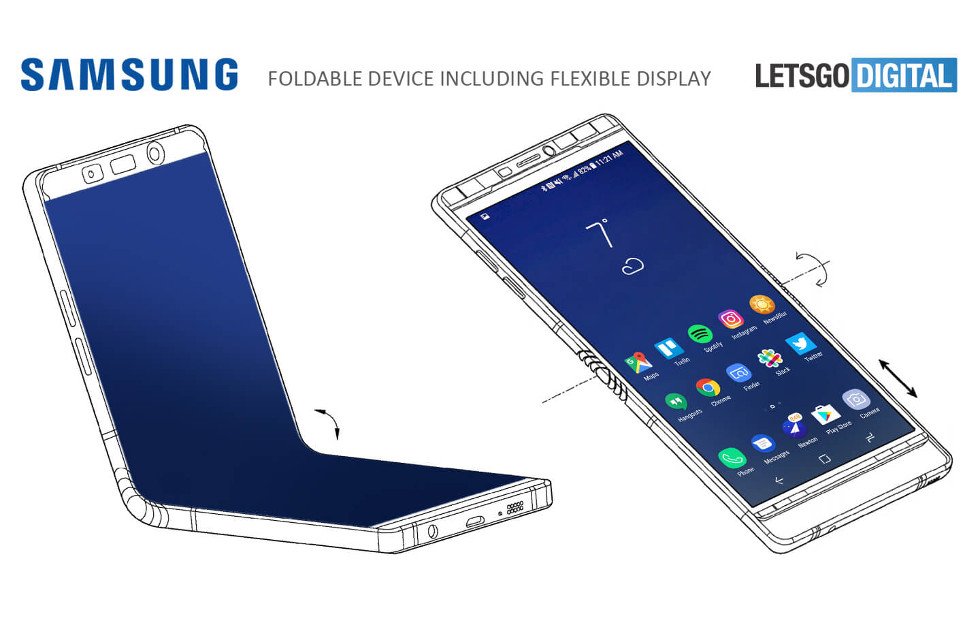The Samsung Galaxy X will undoubtedly be one of the standout smartphones of 2018, but this handset also remains something of a mystery. While it is known that the Korean manufacturer intends for this to be a foldable device, the full details of the Samsung Galaxy X are yet to emerge.
However, the rumor mill has been grinding on this subject, meaning that numerous relevant details have already appeared in the public domain. So here is a rundown of the latest and greatest information regarding this significant release.
Bigger display
The prototype of the Samsung Galaxy X has been doing the rounds at trade shows for many years, and central to its design has always been a larger screen. This is one of the primary motivations for producing a foldable device in the first place, and will undoubtedly be promoted in marketing as a major selling point of the phone.
Samsung patents also point to a device that has the ability to open and close in an inward direction, in the manner of a book, and also horizontally, more like a notepad computer. Whether both of these concepts will arrive in the Samsung Galaxy X, or the Korean manufacturer will choose one or the other, remains to be seen.
But the general consensus of opinion is that the foldable smartphone will have a screen size akin to that of one of the smaller Apple iPad releases. So something in excess of seven-inches can be anticipated. Other reports suggest that the large display will be split into two separate panels, enabling the device to display two different images at once, or simply provide a larger picture.
This is nothing new in the Samsung armory, as the Korean consumer electronics giant has already demonstrated this ability in other product releases. Most notably, its 48-inch ultra-wide computer monitor was capable of this functionality. However, the big advantage of a foldable screen in the smartphone world is to enable the device to be more compact, akin to the clamshell phone that has now fallen somewhat out of fashion.
Bulkier design
Due to the logistical complexity of producing the first commercially viable mainstream foldable smartphone, it has been predicted in many quarters that the Samsung Galaxy X will be bulkier than most modern smartphone releases. Producing a more lithe and light design has obviously been a focus of the mobile industry over several years, but this will be seemingly impossible with such a foldable device.
Of course, it should be emphasized that the foldable smartphone already exists, with a prime example being the ZTE Axon M. This is already marketed as the world’s first foldable smartphone, and it is notable that this device is considerably thicker than the Galaxy S8. This is due to the attachment of displays via a mechanical hinge, possibly similar to the approach that Samsung will take with the Galaxy X.
While there are some very smart engineers working with the Korean electronics behemoth, it will be extremely difficult to produce a Galaxy X device that is as thin as other Samsung releases.
Hefty price tag
New display technologies almost inevitably increase smartphone prices, and this will certainly be the case with the Samsung Galaxy X. It is perhaps this factor above all else which has led the consumer electronics company to seek out a smaller launch in East Asia ahead of a wider roll out of the device.
Already we have seen the price of the iconic iPhone reach $1,000, and the Galaxy X is certainly likely to be in this ballpark. Many factors will impact on the overall price tag of the Samsung Galaxy X, but it will be difficult for such a revolutionary and innovative device to be offered at an affordable recommended retail price.
Specs
With this in mind, we should expect the specifications of the Samsung Galaxy X to be reduced in comparison to other major mobile devices. Factors such as processing power, RAM and storage capacity are all likely to be somewhat modest when compared to the powerhouse Galaxy Note and Galaxy S ranges.
Samsung could also scrimp on external materials in an attempt to keep down costs, and instead emphasize the unique folding screen as the device’s major selling point. The manufacturer must also monitor the success of the device when it launches in Asia, and take account of a world mobile marketplace that has receded nearly 10 percent over the last 12 months.
This will almost certainly lead to limited availability of the Samsung Galaxy X when it is first released.
Edge panel obsolete
One of the interesting predictions made by analysts is that Samsung will completely eliminate its curved display from the Galaxy X, which will mean the end of other software features related to the Edge panel. This feature effectively serves as a second screen for some of Samsung’s existing smartphones, enabling shortcuts to software to be hosted, and other functions to be accessed more easily.
However, it also prevents the main screen from being accessed at the same time, although this wouldn’t hurt the ethos of the Samsung Galaxy X. It should be possible to host more applications on the home screen considering the massive display included in the device, enabling multitasking among apps to be improved.
Two-sided screens
The Samsung Galaxy X could have a massive influence over the entire product range of the Korean company if it is successful, and it is already predicted that future phones from the manufacturer will feature screens on both sides.
Of course, this will be dependent on the public enthusiastically embracing this new concept from Samsung, but market research from the company seemingly indicates that the device will be a success. Samsung has already explicitly stated its determination to release a foldable smartphone in 2018, so the proof will now be in the pudding when the Galaxy X emerges later this year.





